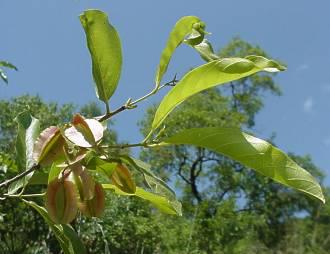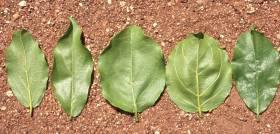Combretum apiculatum subsp. apiculatum
Combretum apiculatum Sond. subsp. apiculatum
Family: Combretaceae
Common names: red bush willow (Eng.); rooiboswilg (Afr.); umbondwe (Zulu); imbondvo (Swazi); mohwidiri (Tswana); mohwelere (Sepedi); muvuvha (Tshivenda); ndhuva (Tsonga)
SA Tree No: 532
Introduction
Combretum apiculatum subsp. apiculatum is an attractive, deciduous, small to medium-sized tree that occurs in various savanna regions, often at low altitudes and in rocky areas, on well-drained soil.

Description
Description
This is a single- or multi-stemmed, small tree 3-10 m high, with a short, often curved trunk, and a spreading, irregular canopy. The long, slender branches hang low down, giving the tree a willow-like appearance. It grows in higher rainfall regions. The bark on the main stem is grey to dark grey or brownish grey and smooth becoming scaly and rough with age.
The simple leaves have sharp, twisted tips, hence the specific epithet; they are shiny yellow-green in colour, alternate, opposite or in whorls of three at the nodes, with blades narrowly to broadly elliptic, oblong or broadly obovate. The base is roundish in outline. Young leaves are sticky.

Flowers occur in axils on new shoots, 3-4 on each shoot. Petals are yellow to creamy green and strongly scented. It flowers in spring and summer, from September to February. The fruit is four-winged, 20-30 x 15-25 mm, almost round to ovoid, with wings up to 7 mm wide, glutinous when young, yellowish-green, often tinged with red. It has a single seed in the centre. It fruits in late summer to autumn, from January to May. Fruits often stay on the tree until the next flowers appear in August.

Subspecies leutweinii from Namibia differs in having hairier leaves. It occurs mainly in Mopane veld.
Conservation Status
Status
It is listed in the 2009 Red Data Listing (Raimondo et al. 2009) but has no threat status.
Distribution and habitat
Distribution description
Red bushwillow is a widespread species in Africa, growing from KwaZulu-Natal and Mpumalanga and Limpopo (South Africa) to Botswana, Mozambique, Namibia, Zimbabwe and other parts of tropical Africa. It occurs in various savanna conditions under medium rainfall to semi arid conditions, at low altitude up to 1400 or 1500 m. It can grow on granitic and rhyolitic soils as well as in rocky places on basalt plains, especially in Mopane woodlands.

Derivation of name and historical aspects
History
Combretum is a Latin name referring to a climbing plant while the term apiculatum refers to the sharp tip of the leaf. Many of the Combretum species are climbers although this species is not.
Ecology
Ecology
The red bush willow is a valuable fodder tree for browsing animals; mature green leaves are eaten by kudu, bushbuck, eland, giraffe and elephant. Cattle like the leaves when they are about to fall or have fallen, especially when they are least nutritious. It is considered as an indicator of mixed veld, good for spring- and summer grazing by most farmers but needs careful management. Its fruits pose a threat to livestock, especially the seeds which are poisonous but eaten by Brown-headed Parrots. The sweetly scented flowers are visited by bees and ants.

Uses
Use
The wood is very hard, making it resistant to both borers and termites; it provides useful fencing poles, mine props and wheel spokes, and makes good furniture, but as the pieces are not large, they can only be used to make small items. It also makes good firewood and charcoal. The bark is used for tanning leather. Medicinally, a decoction of the leaves has been used as a steam bath and as an enema to relieve stomach disorders. As treatment for conjunctivitis, an ash from the burnt stem is mixed with white clay and water and the resulting paste is spread over the face.
Growing Combretum apiculatum subsp. apiculatum
Grow
This is an attractive garden tree, with brownish red or golden yellow autumn colours and it grows into a lovely shade tree. An established tree is frost- and drought-resistant. It can be grown from seed and is slow-growing. It prefers sandy soil or rocky areas with clay soil.
References
- Coates Palgrave, M. 2002. Keith Coates Palgrave Trees of southern Africa, edn 3. Struik, Cape Town.
- Grant, R. & Thomas, V. 1999. Sappi tree spotting. Tree identification made easy, KwaZulu-Natal coast and Midlands. Jacana, Johannesburg.
- Palmer, E. & Pitman, N. 1972. Trees of southern Africa. Balkema, Cape Town.
- Van Wyk, B. (A.E.) & Van Wyk, P. 1997. Field guide to trees of southern Africa. Struik, Cape Town.
- Van Wyk, B.-E. & Gericke, N. 2000. People's plants. A guide to useful plants of southern Africa. Briza Publications, Pretoria.
Credits
Thabo Masupa & Esther Rampho
Pretoria National Herbarium
January 2011
Plant Attributes:
Plant Type: Tree
SA Distribution: Gauteng, KwaZulu-Natal, Limpopo, Mpumalanga, North West
Soil type: Sandy, Clay, Loam
Flowering season: Spring, Late Summer
PH:
Flower colour: Green, Cream, Yellow
Aspect: Full Sun
Gardening skill: Average
Special Features:
Horticultural zones









Rate this article
Article well written and informative
Rate this plant
Is this an interesting plant?
Login to add your Comment
Back to topNot registered yet? Click here to register.